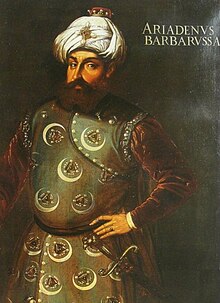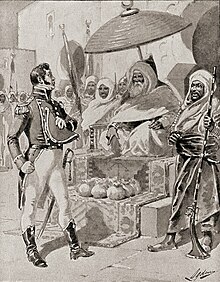| Revision as of 10:36, 24 October 2010 editPer Honor et Gloria (talk | contribs)Autopatrolled, Pending changes reviewers53,031 edits status← Previous edit | Revision as of 10:46, 24 October 2010 edit undoPer Honor et Gloria (talk | contribs)Autopatrolled, Pending changes reviewers53,031 edits →Barbary Wars: imNext edit → | ||
| Line 86: | Line 86: | ||
| ===Barbary Wars=== | ===Barbary Wars=== | ||
| ] paying tribute to the Dey of Algiers for the ] circa 1800.]] | |||
| ] in 1816, by ].]] | ] in 1816, by ].]] | ||
| During the early 19th century, the Regency of Algiers again resorted to widespread ] against shipping from Europe and the young ], mainly due to internal fiscal difficulties.<ref name="Bosworth 24"/> This in turn led to the ], which culminated in August 1816 when ] executed a naval ]. | During the early 19th century, the Regency of Algiers again resorted to widespread ] against shipping from Europe and the young ], mainly due to internal fiscal difficulties.<ref name="Bosworth 24"/> This in turn led to the ], which culminated in August 1816 when ] executed a naval ]. | ||
Revision as of 10:46, 24 October 2010
| Regency of Algiers | |||||||||||||
|---|---|---|---|---|---|---|---|---|---|---|---|---|---|
| c. 1525–1830 | |||||||||||||
 Flag
Flag | |||||||||||||
 Map of the Regency of Algiers in 1835. Map of the Regency of Algiers in 1835. | |||||||||||||
| Status | Regency of the Ottoman Empire | ||||||||||||
| Capital | Algiers | ||||||||||||
| Religion | Islam (Maliki and Hanafi), Judaism | ||||||||||||
| Government | Regency | ||||||||||||
| Pasha, Dey | |||||||||||||
| History | |||||||||||||
| • Established | c. 1525 | ||||||||||||
| • Disestablished | 1830 | ||||||||||||
| Population | |||||||||||||
| • 1808 | 3,000,000 | ||||||||||||
| |||||||||||||
The Regency of Algiers was an Ottoman territory centered on Algiers, in modern Algeria. It was established around 1525, when Hayreddin Barbarossa re-captured the city. It roughly covered the area of modern Algeria, between the states of Tunisia and Morocco. It rivaled and displaced the Zianids, the Hafsids and the Spanish possessions in northern Africa, and became a major hub of Mediterranean piracy, until the French invasion of Algiers in 1830.
Establishment

The Regency of Algiers was the principal center of Ottoman Empire power in the Maghreb. It was also a base from which attacks were made on European shipping.
Base in the war against Spain
Aruj, Barbarossa's brother, had accomplished the Capture of Algiers in 1516, appart for the Spanish Peñon. Following the death of Aruj, Barbarossa asked for assistance to the Ottoman Empire, in exchange for acknowledging Ottoman rule in his dominions. The Spanish retook the city of Algiers in 1519, before Ottoman help could arrive, but Barbarossa recaptured the city definitively in 1525, and the Spanish Peñon as well in 1529, in the Capture of Algiers (1529).
Hayreddin Barbarossa established the military basis of the regency. The Ottomans provided a supporting garisson of 2,000 Turkish troops with artilley. He left Hasan Agha in command as his deputy when he had to leave for Istanbul in 1533.
The son of Barbarossa, Hasan Pashan was the first governor of the Regency to be directly appointed by the Ottoman Empire in 1544, when his father retired, and took the title of beylerbey.
Beylerbeys continued to be nominated for unlimited tenures until 1587, when the Ottoman Empire set up a regular Ottoman administration in Algiers and its dependencies, headed by Pashas, with 3 year terms. This was a way o considate Ottoman power in the Maghreb, after Spain had sent an embassy to Istanbul in 1578 to negotiate a truce, leading to a formal peace in August 1580. From that point the Regency of Algiers was a formal Ottoman territory, rather than just a military base in the war against Spain.
Mediterranean piracy



Despite the end of formal hostilities with Spain, attacks on Christian, and especially Catholic shipping, with slavery for the captured, became prevalent in Algiers, and was actually the main activity and source of revenues of the Regency.
In the early 16th century, Algiers also became with other North African harbours such as Tunis, one of the bases for Anglo-Turkish piracy, with as many ass 8,000 renegades operating from the city in 1634.
A contemporary letter states: {{quote|"The infinity of goods, merchandise jewels and treasure taken by our English pirates daily from Christians and carried to Allarach, Algire and Tunis to the great enriching of Mores and Turks and impoverishing of Christians"|Contemporary letter sent from Portugal to England.
Piracy and slavery of Christians originating from Algiers were a major problem throughout the centuries, leading to regular punitive expeditions by European powers. Spain (1567, 1775, 1783), Danemark (1770), France (1661, 1665, 1682, 1683, 1688), England (1622, 1655, 1672), all led naval bombardments against Algiers. Abraham Duquesne fought the Barbary pirates in 1681 and bombarded Algiers between 1682 and 1683, to help Christian captives.
Barbary Wars


During the early 19th century, the Regency of Algiers again resorted to widespread piracy against shipping from Europe and the young United States of America, mainly due to internal fiscal difficulties. This in turn led to the Barbary Wars, which culminated in August 1816 when Lord Exmouth executed a naval Bombardment of Algiers.
French invasion

As of 1808, the population of the Regency of Algiers numbered around 3 million people, of whom 10,000 were Turks, and 5,000 Kulughlis (from kul oġlu, "son of Janissaries", i.e. metis of Turks and local women).
During the Napoleonic Wars, the Regency of Algiers had greatly benefited from trade in the Mediterranean, and of the massive imports of food by France, largely bought on credit by France. In 1827, Hussein Dey, Algeria's Ottoman ruler, demanded that the French pay a 31-year old debt, contracted in 1799 by purchasing supplies to feed the soldiers of the Napoleonic Campaign in Egypt.
The French consul Pierre Deval refused to give answers satisfactory to the dey, and in an outburst of anger, Hussein Dey touched the consul with his fan. Charles X used this as an excuse to break diplomatic relations. The regency of Algiers would end with the French invasion of Algiers in 1830, and French rule last for the next 132 years.
See also
Notes
- ^ Abun-Nasr, Jamil (20 August 1987). A history of the Maghrib in the Islamic period. Cambridge University Press. p. 151ff. ISBN 9780521337670. Retrieved 24 October 2010.
{{cite book}}: CS1 maint: year (link) - ^ Naylorp, by Phillip Chiviges (2009). North Africa: a history from antiquity to the present. University of Texas Press. p. 117. ISBN 978-0-292-71922-4. Retrieved 24 October 2010.
- ^ Bosworth, Clifford Edmund (30 January 2008). Historic cities of the Islamic world. Brill Academic Publishers. p. 24. ISBN 978-9004153882. Retrieved 24 October 2010.
- Tenenti, Alberto Tenenti (1967). Piracy and the Decline of Venice, 1580-1615. University of California Press. p. 81. Retrieved 24 October 2010.
- Harris, Jonathan Gil (2003). Sick Economies: Drama, mercantilism, and disease in Shakespeare's England. University of Pennsylvania Press. p. 152ff. ISBN 978-0-8122-3773-3. Retrieved 24 October 2010.
- Martin, Henri (1864). Martin's History of France. Walker, Wise & Co. p. 522. Retrieved 24 October 2010.
- Isichei, Elizabeth Isichei (1997). A history of African societies to 1870. Cambridge University Press. p. 273. ISBN 0-521-45444-1. Retrieved 24 October 2010.